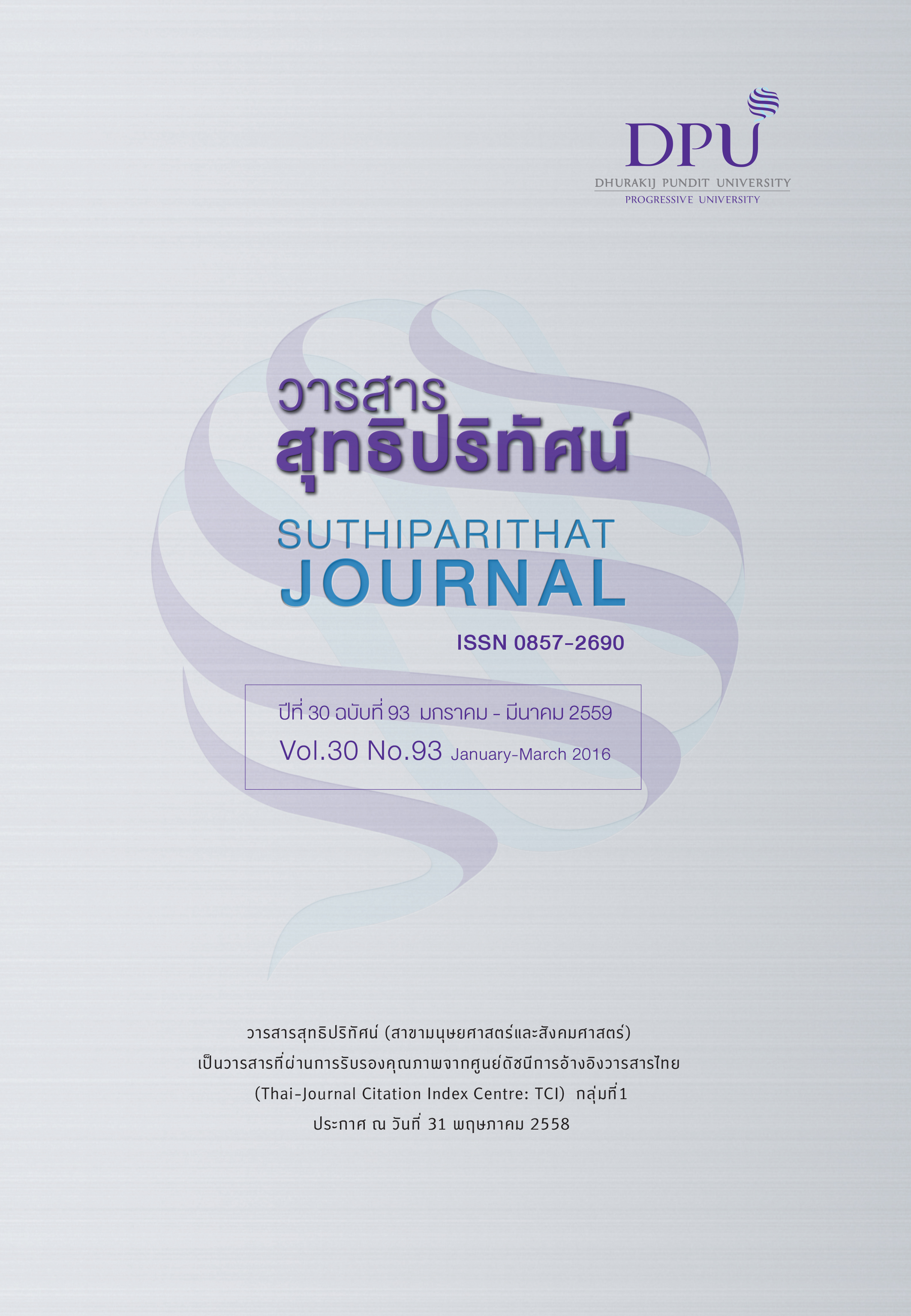การพัฒนาพาณิชย์อิเล็กทรอนิกส์สำหรับผู้ประกอบการด้านการท่องเที่ยวขนาดกลางและขนาดย่อมในประเทศไทย: รูปแบบ การพัฒนาแบบเป็นขั้นตอน
คำสำคัญ:
การได้เปรียบในการแข่งขัน, พาณิชย์อิเล็กทรอนิกส์, การพัฒนาพาณิชย์อิเล็กทรอนิกส์, ทฤษฎี eMICA, ธุรกิจด้านการท่องเที่ยวบทคัดย่อ
พาณิชย์อิเล็กทรอนิกส์ถูกนำมาใช้มากขึ้นเพื่อเพิ่มขีดความสามารถในการแข่งขันและสร้าง ความได้เปรียบของธุรกิจในอุตสาหกรรมการท่องเที่ยว รวมทั้งเพื่อเพิ่มประสิทธิภาพในการดำเนินงาน ลดต้นทุน สร้างความใกล้ชิดให้กับลูกค้าและผู้จัดจำหน่ายมากขึ้น ตลอดจนนำเสนอสินค้าและบริการตาม ความต้องการของผู้บริโภคเฉพาะกลุ่มได้ แต่อย่างไรก็ตาม การนำพาณิชย์อิเล็กทรอนิกส์มาใช้ในธุรกิจ ด้านการท่องเที่ยวของไทยยังมีอยู่อย่างจำกัดเนื่องจากอาจเป็นเรื่องใหม่สำหรับผู้ประกอบการ บทความนี้ จึงเป็นการนำเสนอแนวทางการพัฒนาพาณิชย์อิเล็กทรอนิกส์สำหรับผู้ประกอบการด้านการท่องเที่ยวเพื่อนำ ไปประยุกต์ใช้ในการดำเนินงาน โดยใช้ทฤษฎีว่าด้วยการต่อยอดรูปแบบการใช้อินเทอร์เน็ตในเชิงพาณิชย์ (The Theory of Extended Model of Internet Commerce Adoption: eMICA) ซึ่งพัฒนาโดย Burgess, Cooper, and Alcock (2001) ซึ่งทฤษฎีนี้ถูกนำมาใช้เพื่อนำเสนอขั้นตอนต่างๆ ของการพัฒนาเว็บไซต์และ แบ่งออกได้เป็น 3 ขั้นตอน คือ ขั้นตอนที่1 เป็นการใช้เว็บไซต์เพื่อการส่งเสริมสินค้าและบริการของบริษัท ขั้นตอนที่สอง เป็นการนำเสนอข้อมูลข่าวสารและการบริการ ซึ่งจะมีลักษณะเป็นการสื่อสารแบบสองทาง ระหว่างธุรกิจและลูกค้า และ/หรือระหว่างธุรกิจด้วยกัน และขั้นตอนที่สาม เป็นการประมวลผลด้านธุรกรรม ซึ่งเป็นขั้นตอนสุดท้ายที่ก้าวหน้าที่สุดในการทำธุรกรรมออนไลน์ นอกจากนี้ บทความนี้ยังได้นำเสนอปัจจัย สนับสนุนและอุปสรรคในแต่ละขั้นตอนของการพัฒนาพาณิชย์อิเล็กทรอนิกส์ เพื่อเป็นแนวทางในการปรับปรุง ธุรกิจ และวางแผนงานเพื่อพัฒนาพาณิชย์อิเล็กทรอนิกส์ของธุรกิจด้านการท่องเที่ยวของไทยในการพัฒนา ศักยภาพของธุรกิจอย่างมีประสิทธิภาพและยั่งยืนต่อไป
เอกสารอ้างอิง
กระทรวงการท่องเที่ยวและกีฬา. (2553). ประกาศคณะกรรมการนโยบายการท่องเที่ยวแห่งชาติ. สืบค้น 20 สิงหาคม2557, จาก http://www.tica.or.th/images/plan_tourism2555-2559/2555-2559.pdf
นฤมล ชูชินปราการ. (2557). กลยุทธ์การใช้พาณิชย์อิเล็กทรอนิกส์สำหรับวิสาหกิจขนาดกลางและขนาดย่อม (SMEs) ท่องเที่ยวของไทย (รายงานผลการวิจัย). ชลบุรี: มหาวิทยาลัยบูรพา.
สำนักงานพัฒนาวิทยาศาสตร์และเทคโนโลยีแห่งชาติ. (2557). 9 แนวโน้มการค้าออนไลน์ไทยปี 2556. สืบค้น 20 มีนาคม 2557, จาก http://www.nstda.or.th/component/search/
สำนักงานสถิติแห่งชาติ. (2554). รายงานผลทีสำคัญสำรวจสถานภาพการพาณิชย์อิเล็กทรอนิกส์ของประเทศไทย พ.ศ. 2554. สืบค้น 15 มีนาคม 2557, จาก http://service.nso.go.th/nso/nsopublish/themes/files/electThaiRep54.pdf
สำนักงานส่งเสริมวิสาหกิจขนาดกลางและขนาดย่อม. (2554). นิยามSMEs. สืบค้น 15 ธันวาคม 2555, จาก http://www.sme.go.th/Pages/Define/Define.aspx
ASTVManagerOnline. (2556). นักท่องเที่ยวไทย ฮิตใช้เฟซบุ๊คเวลาเดินทาง. สืบค้น 10 ธันวาคม 2556, จาก http://www.manager.co.th/Travel/ViewNews.aspx?NewsID=9560000051438
Asia Pacific Economic Cooperation (APEC). (1999). SME electronic commerce study – final report. Retrieved September 24, 2014, from http://www.apecsec.org.sg/download/tel/SME_E-Commerce_study.exe
Barry, D. (2000). From Appalachia to India: US small businesses are going global. Business Credit, 102(6) June, 49-50.
Burgess, L. & Cooper, J. (2000, November). Extending the viability of MICA (Model of Internet Commerce Adoption) as a metric for explaining the process of business adoption of Internet commerce, Paper presented at the International Conference on Telecommunications & Electronic Commerce, Dallas.
Doolin, B., Burgess, L. & Cooper, J. (2002). Evaluating the use of the Web for tourism marketing: a case study from New Zealand. Tourism Management, 23, 557-561.
Burgess, L., Cooper, J. & Alcock, C. (2001). The adoption of the Web as a marketing tool by Reginal Tourism Associations (RTAs) in Australia. ACIS2001 Proceedings. Retrieved June 20, 2012, from: http://aisel.aisnet.org/acis2001/9
Chapman, S., Ettkin, L.P. & Helms, M. (2000, August). Do small businesses need supply chain management?. IIE Solutions, 32(8), 31-35.
Chen, J. & McQueen, R.J. (2008). Factors affecting e-commerce stages of growth in small Chinese firms in New Zealand: An analysis of adoption motivators & inhibitors. Journal of Global Information Management, 16(1), 26-60.
Chinmaneevong, C. (2015, October 6) TAT intends to boost domestic tourism. Bangkok Post, Retrieved October 1, 2015, from: http://www.bangkokpost.com/business/tourism-and-transport/719284/tat-intends-to-boost-domestic-tourism
Doolin, B., Burgess, L. & Cooper, J. (2002). Evaluating the use of the Web for tourism marketing: a case study from New Zealand. Tourism Management, 23, 557-561.
Durlacher Research Limited. (2000, August). The Durlacher Quarterly Internet Report. SME Edition, available at: www.durlacher.com: In Rao, S.S., Metts, G. & Monge, C.A.M. (2003). Electronic commerce development in small & medium sized enterprises: A stage model & its implications. Business Process Management Journal, 9(1), 11-32.
International Trade Centre UNCTAD/WTO. (2005). Business navigator on e-finance for SMEs exporters in developing countries. Retrieved February 26, 2015, from: http://www.intracen.org/WorkArea/DownloadAsset.aspx?id=32447
Intrapairot, A. & Srivihok, A. (2002). The e-Commerce of SMEs in Thailand. Retrieved May 30, 2012, from: http://pdf.aminer.org/000/305/994/supporting_smes_in_the_world_of_ecommerce_www_site_maintenance.pdf
Jeffcoate, j., Chappell, C. & Feindt, S. (2000). Attitudes towards process improvement among SME’s involved in e-commerce. Knowledge & Process Management, 7(3), 187-195.
Kommerskollegium. (2012). E-commerce – New Opportunities, New Barriers: A survey of e-commerce barriers in countries outside the EU. National Board of Trade, November 2012. ISBN: 978-91-86575-53-3. Retrieved February 27, 2015, from: https://www.wto.org/english/tratop_e/serv_e/wkshop_june13_e/ecom_national_board_e.pdf
Larson, T. & Ankomah, P. (2004). Evaluating Tourism Web Site Complexity: The Case of International Tourism in the U.S. Services Marketing Quarterly, 26(2), 23-37. DOI: 10.1300/J396v26n02_02. Retrieved May 30, 2012, from: http://dx.doi.org/10.1300/J396v26n02_02
Laudon, K.C. & Laudon, J.P. (2009). Management Information Systems: Managing the Digital Firm (11th ed.). New Jersey: Prentice Hall.
Mamaghani, F. (2009). Impact of E-Commerce on Travel & Tourism: An Historical Analysis. International Journal of Management, 26(3). Retrieved October 31, 2014, from https://www.questia.com/library/journal/1P3-1889954271/impact-of-e-commerce-on-travel-&-tourism-anhistorical
Maswera, T., Dawson, R. & Edwards, J. (2008). E-commerce adoption of travel and tourism organisations in South Africa, Kenya, Zimbabwe and Uganda. Telematics and Informatics, 25, 187-200.
NSO (The National Statistical Office). (2014). The 2013 Survey of E-Commerce Status in Thailand: Executive Summary. Retrieved October 1, 2015, from: http://web.nso.go.th/en/survey/ict/data_ict/560514_Electric_13.pdf
O’Brien, J.A. & Marakas, G.M. (2008), Introduction to Information Systems (14th ed.). Burr Ridge, Illinois: McGraw-Hill.
O’Corner, G. & O’Keefe, B. (1997). Viewing the Web as a marketplace: the case of small companies. Decision Support Systems, 21(3), 171-183.
Pesonen, J & Palo-oja, O.M. (2010). Comparing Internet commerce adoption between the Finnish & the European independent accommodation companies. In: Ulrike Gretzel, Rob Law & Matthias Fuchs (Eds.) Information and Communication Technologies in Tourism, ENTER 2010. Lugano, Switzerland 10-12 October 2010, 51-62.
Rao, S.S., Metts, G. & Monge, C.A.M. (2003). Electronic commerce development in small and medium sized enterprises: A stage model and its implications. Business Process Management Journal, 9(1), 11-32.
Reynolds, J. (2006). The Complete E-Commerce Book. Berkeley: Group West.
Sanderson, M. (2000). Where will your e-commerce disputes be resolved?. Network Security, 4, April, 11-12.
Teo, T.S.H. & Pian, Y. (2004). A model for web adoption. Information and Management, 41(4), 457-468.
Thong, J.Y.L. (1999). An integrated model of information systems adoption in small businesses. Journal of Management Information Systems, 15(4), 187-214.
Timmers, P. (1998). Business models for electronic markets. Electronic Markets, 8(2), 1-8.
Timmers, P. (2000). Going global’ in electronic commerce. Management en Information, 5, October, available at: http://europa.eu.int/ISPO/ecommerce/ethesis/GoingGlobal.doc: In Rao, S.S.,
Metts, G. & Monge, C.A.M. (2003). Electronic commerce development in small and medium sized enterprises: A stage model and its implications. Business Process Management Journal, 9(1), 11-32.
Turban, E., King, D., McKay, J., Marshall, P., Lee, J. & Viehland, D. (2008). Electronic commerce 2008: a managerial perspective. New Jersey: Prentice Hall.
Walczuch, R., Braven, G. & Lundgren, H. (2000). Internet adoption barriers for small firms in the
Netherlands.European Management Journal, 18(5), 561-572.
Zhivago, K. (2000). Global patchwork: ‘Us vs them’ doesn’t have to be a dilemma. MC Technology Marketing Intelligence, 20(3), 97.
ดาวน์โหลด
เผยแพร่แล้ว
รูปแบบการอ้างอิง
ฉบับ
ประเภทบทความ
สัญญาอนุญาต
เนื้อหาและข้อมูลในบทความที่ลงตีพิมพ์ในวารสารสุทธิปริทัศน์ ถือเป็นข้อคิดเห็นและความรับผิดชอบของผู้เขียนบทความโดยตรงซึ่งกองบรรณาธิการวารสาร ไม่จำเป็นต้องเห็นด้วย หรือร่วมรับผิดชอบใด ๆ
บทความ ข้อมูล เนื้อหา รูปภาพ ฯลฯ ที่ได้รับการตีพิมพ์ในวารสารสุทธิปริทัศน์ ถือเป็นลิขสิทธิ์ของวารสารสุทธิปริทัศน์หากบุคคลหรือหน่วยงานใดต้องการนำทั้งหมดหรือส่วนหนึ่งส่วนใดไปเผยแพร่ต่อหรือเพื่อกระทำการใด ๆ จะต้องได้รับอนุญาตเป็นลายลักษณ์อักษรจากวารสารสุทธิปริทัศน์ก่อนเท่านั้น







